Moniek Bloks's Blog, page 109
July 28, 2022
The Serpent Queen official trailer
Samantha Morton, also known for her role as Mary, Queen of Scots in Elizabeth: The Golden Age, will portray Catherine de’ Medici, Queen of France, in the upcoming series The Serpent Queen.
Samantha Morton will star alongside Charles Dance as Pope Clement, Liv Hill as the younger version of Catherine, Antonia Clarke as Mary, Queen of Scots, and Ludivine Sagnier as Diane de Poitiers. The series will premier on STARZ on 11 September.
The post The Serpent Queen official trailer appeared first on History of Royal Women.
A first look at the new Sisi film Corsage
A happy coincidence, as Netflix prepares to release a new series about Empress Elisabeth, we also get a brand new film about her. Corsage follows Empress Elisabeth (Sisi) from Christmas 1877 as she celebrates her 40th birthday. As she ages, she refuses to be painted and photographed and is desperate to maintain her image.
The trailer is certainly something else, and I can’t wait to see it.
There is currently no US release date, although I expect it won’t be too long before we see one.
The post A first look at the new Sisi film Corsage appeared first on History of Royal Women.
July 26, 2022
Princess Taiping – The most powerful Princess of the Tang Dynasty (Part two)
Princess Taiping was the most powerful and influential princess of the Tang dynasty. In my last article, I discussed Princess Taiping’s part she played in her mother, Empress Wu’s abdication and the restoration of her brother, Emperor Zhongzong, to the throne. In my second article on Princess Taiping, I will detail the power and influence she wielded during Emperor Zhongzong’s reign. While she wielded immense power and influence, she would find Empress Wei to be a difficult political rival. Throughout Emperor Zhongzong’s reign, the two fought each other for power. However, only one would be the victor. In this article, I will discuss how she ousted Empress Wei and restored her other brother, Emperor Ruizong, to the throne.
In 705 C.E., Princess Taiping contributed to restoring her brother, Emperor Zhongzong, to the throne. Emperor Zhongzong was immensely grateful to Princess Taiping. He gave Princess Taiping an honorary title. He also rewarded her with more territory, and she received her own office and staff. Princess Taiping became very influential during Emperor Zhongzong’s reign. It was said that upon her brother’s accession to the throne, Princess Taiping grew increasingly arrogant and was deeply involved in court politics.[1] She recommended officials to high positions to the Emperor.[2] Princess Taiping was also known for being generous among the poor, and she often gave them money.[3] She supported many writers and scholars.[4] Thus, she grew in popularity and had many supporters.[5]
Even though Princess Taiping wielded immense influence at court, she greatly disliked her brother, Emperor Zhongzong. She found him to be a weak ruler who was often at the hands of his powerful, ambitious, and scheming wife, Empress Wei. [6] Princess Taiping was often at odds with Empress Wei and Imperial Consort Shangguan Wan’er, the consort of Emperor Zhongzong.[7] They both viewed Princess Taiping as a political rival and were jealous of her strategic mind, which they found was superior to theirs.[8] Their rivalry escalated when Emperor Zhongzong died on 3 July 710 C.E., and Empress Wei became regent to Prince Li Chongmao (Emperor Zhongzong’s son by a concubine).
In July 710 C.E., Empress Wei planned to usurp the throne and declare herself female Emperor of China like her mother-in-law, Wu Zetian.[9] Before she could make her daring move, she had to eliminate her brother-in-law, Prince Li Dan and Princess Taiping.[10] However, Princess Taiping and Prince Li Dan had already been conspiring for some time to oust the throne from Empress Wei.[11] Therefore, when Empress Wei sent assassins to murder them, Princess Taiping and her son, Xue Chongjian, had already joined the army of Prince Li Longji (Prince Li Dan’s son and the future Emperor Xuanzong).[12]
On the night of 21 July 710 C.E., Prince Li Longji attacked the palace. Empress Wei was murdered. However, no one wanted to make a move against the boy emperor and put Prince Li Dan on the throne.[13] This was because of the Emperor’s age. They believed he was too young to be harmed.[14] When no one made a move, it was Princess Taiping who took the first step.[15] She boldly told the boy emperor, “Everybody turns to the prime minister, little boy; this is not your seat.” [16] After she said these words, she grabbed the boy emperor and pulled him away from the throne.[17] This encouraged Prince Li Dan to hesitantly take his seat upon the throne.[18] He was then proclaimed Emperor.[19] He officially took the throne as Emperor Ruizong on 25 July 713 C.E. Emperor Ruizong knew Princess Taiping’s contribution in restoring him to the throne and would greatly reward her.[20] During Emperor Ruizong’s reign, Princess Taiping would be the most powerful woman in Tang China.[21]
During Emperor Zhongzong’s reign, Princess Taiping and Empress Wei were the two most powerful women in Tang China. Yet, they realized they could not share power with each other. This was why one of them had to die.[22] In the end, it was Princess Taiping who came out the victor. Under Emperor Ruizong’s reign, she was the uncontested most powerful woman in Tang China.[23] Emperor Ruizong loved and respected her.[24] However, she soon gained another enemy. This enemy would prove to be her undoing. The enemy was Li Longji, who would become Emperor Xuanzong. In my next article (coming soon), I will discuss the hostile relationship between Princess Taiping and Emperor Xuanzong. This relationship would lead Princess Taiping to do the most daring action she would ever do in her lifetime. She would try to be the next female Emperor of China. However, she would ultimately lose everything that was dear to her, including her life.
Sources:
Aiwen, L. (2015). “Princess Taiping”. Notable Women of China: Shang Dynasty to the Early Twentieth Century. (B. B. Peterson, Ed. Y. Jun, trans.). London: Routledge. pp. 206-209
McMahon, K. (2013). Women Shall Not Rule: Imperial Wives and Concubines in China from Han to Liao. NY: Rowman and Littlefield.
Lee, L. X.H. (2014). “Li, Princess Taiping.” Biographical Dictionary of Chinese Women, Volume II: Tang Through Ming 618 – 1644. (L. X. H. Lee, Ed.; A. D. Stefanowska, Ed.; S. Wiles, Ed.). NY: Routledge. pp. 200-203
[1] Lee, 2014
[2] Aiwen, 2015
[3] Lee, 2014
[4] Lee, 2014
[5] Lee, 2014
[6] Aiwen, 2015
[7] Lee, 2014
[8] Lee, 2014
[9] Lee, 2014
[10]Lee, 2014
[11]Lee, 2014
[12]Lee, 2014
[13] Aiwen, 2015
[14] Aiwen, 2015
[15] Lee, 2014
[16] Aiwen, 2015, p. 208
[17] Aiwen, 2015
[18] Lee, 2014
[19] Aiwen, 2015
[20] Lee, 2014
[21] McMahon, 2013
[22] Lee, 2014
[23] McMahon, 2013
[24] Lee, 2014
The post Princess Taiping – The most powerful Princess of the Tang Dynasty (Part two) appeared first on History of Royal Women.
July 24, 2022
Princess Taiping – The most powerful Princess of the Tang Dynasty (Part one)
Princess Taiping was the most powerful and influential princess of the Tang Dynasty. She has left a tremendous mark in Chinese history that is impossible to overlook. No princess in Chinese history has ever wielded as much political influence or changed the course of history compared to Princess Taiping. Princess Taiping was a significant key player in the events of the Tang Dynasty. She helped dethrone her mother, Empress Wu, and restore both of her brothers, Emperor Zhongzong and Emperor Ruizong, to the throne. Yet her greatest legacy was her boldness in trying to become a female emperor of China, and she ultimately lost.
It is no wonder that Princess Taiping has managed to capture the imagination of popular media and why she is featured in many Chinese dramas, including a drama based on her life called Palace of Desire, in which she is played by Chen Hong. Because no Chinese princess has ever come close to matching her in history, I have decided to spend three articles discussing her life and the role she played. It makes one wonder why she would dare to try to usurp the throne for herself. In this first article, I will focus on the relationship she had with her mother, Empress Wu Zetian, and the role she played in restoring her brother, Emperor Zhongzong, to the throne.
Princess Taiping was born sometime after the year of 662 C.E. The date of her birth year and her personal name are unknown.[1] We only know her surname Li because that was the surname of the imperial family. She was the youngest of the three daughters of Emperor Gaozong and Empress Wu. At the age of six, the princess’s maternal grandmother, Lady Rong, died. The princess was sent to a Taoist Temple to pray for her grandmother.[2] When she was thirteen, the King of Tibet asked for the princess’s hand in marriage.[3] Empress Wu was very attached to her youngest daughter and did not want to send her to a foreign land. Empress Wu and Emperor Gaozong built a Taoist temple which they named Taiping and appointed the princess as the head of the temple.[4] This was how she became known as Princess Taiping[5]. Princess Taiping was a nun only in name because her parents had marriage plans for her that were closer to home.[6] Princess Taiping was also not serious about being the leader of Taiping Temple and performed none of the duties that were were required of her within the temple.[7]
Princess Taiping was known to be tall, plump, and she had a chubby face (which was seen as “a richness and honor in ancient China”[8]).[9] She was said to be “bright, courageous, and resolute.”[10] She was Empress Wu’s favourite because the empress believed Princess Taiping took after her in personality and looks.[11] Empress Wu often discussed politics with Princess Taiping, and Princess Taiping became adept in politics.[12]
In 681 C.E., Princess Taiping married her first cousin, Xue Shao (the son of her paternal aunt, Princess Chengyang).[13] Princess Taiping loved him and their marriage was very happy. She bore him two sons and two daughters.[14] In 688 C.E., Princess Taiping’s husband, Xue Shao, was sentenced to die of starvation for being part of a rebellion against Empress Wu.[15] Empress Wu planned to marry Princess Taiping to her nephew, Wu Chengsi.[16] When Wu Chengsi contracted a disease, Empress Wu found him an unsuitable candidate.[17] Empress Wu chose Wu Youji, her brother’s grandson, to be the next husband for Princess Taiping.[18] There was an obstacle to the match as Wu Youji was already married.[19] Empress Wu hired an assassin to kill Wu Youji’s wife.[20] Immediately after Wu Youji became a widower, he married Princess Taiping.[21] Princess Taiping bore him two sons and one daughter.[22]
Late in Empress Wu’s reign, Princess Taiping often found herself losing influence with her mother.[23] Empress Wu preferred her male favourites, the Zhang brothers, over Princess Taiping.[24] Princess Taiping disliked the Zhang brothers.[25] She was appalled by the Zhang brothers’ extravagant lifestyle and believed that her mother’s court should promote morality.[26] In 705 C.E., she joined a coup that killed the Zhang brothers, ousted her mother from the throne, and restored her brother, Emperor Zhongzong, to the throne.[27] Emperor Zhongzong recognised the role his sister played in restoring his throne (Emperor Zhongzong was emperor before in 684, but his mother deposed him in favour of his younger brother, Li Dan).[28] He gave her the honorary title of Princess Zhenguo Taiping (which meant “Princess Taiping Stabilized the Nation”[29]). He rewarded her with more territory.[30] Princess Taiping also had her own office and staff.[31] Princess Taiping was rewarded immensely for the throne. However, she would soon realize that she had a new rival, Empress Wei.[32]
The early life of Princess Taiping showed that she was the protégé of Empress Wu. Empress Wu often discussed politics with Princess Taiping and had moulded her to be a capable politician. She had Empress Wu’s looks and temperament. Still, Princess Taiping could not control the events of her life. Her husband whom she dearly loved died of starvation at the hands of her mother. Empress Wu forced her to marry another. The death of her first husband and her forced remarriage seemed to have had a profound effect on her. This had made her ambitious and power-hungry.[33] It is no wonder that she turned to politics, which she found more controllable.[34] In my next article (coming soon), I will describe the rivalry between two powerful women, Princess Taiping and Empress Wei. The two of them fought each other for power. However, only one of them proved to be victorious.
Sources:
Aiwen, L. (2015). “Princess Taiping.” Notable Women of China: Shang Dynasty to the Early Twentieth Century. (B. B. Peterson, Ed. Y. Jun, trans.). London: Routledge. pp. 206-209
McMahon, K. (2013). Women Shall Not Rule: Imperial Wives and Concubines in China from Han to Liao. NY: Rowman and Littlefield.
Lee, L. X.H. (2014). “Li, Princess Taiping.” Biographical Dictionary of Chinese Women, Volume II: Tang Through Ming 618 – 1644. (L. X. H. Lee, Ed.; A. D. Stefanowska, Ed.; S. Wiles, Ed.). NY: Routledge. pp. 200-203.
[1] Lee, 2014
[2] Aiwen, 2015
[3] Lee, 2014
[4] Lee, 2014
[5] Aiwen, 2015
[6] Lee, 2014
[7] Lee, 2014
[8] Aiwen, 2015, p. 206
[9] Aiwen, 2015
[10] Aiwen, 2015, p. 206
[11] McMahon, 2013
[12] Lee, 2014
[13] Aiwen, 2015
[14] Aiwen, 2015
[15] Lee, 2014
[16] Lee, 2014
[17] Lee, 2014
[18] Aiwen, 2015
[19] Lee, 2014
[20] Lee, 2015
[21] Aiwen, 2015
[22] Aiwen, 2015
[23] Aiwen, 2015
[24] Aiwen, 2015
[25] Aiwen, 2015
[26] Aiwen, 2015
[27] Aiwen, 2015
[28] Lee, 2015
[29] Lee, 2014, pp. 201-202
[30] Aiwen, 2015
[31] Lee, 2014
[32] McMahon, 2013
[33] Lee, 2014
[34] McMahon, 2013
The post Princess Taiping – The most powerful Princess of the Tang Dynasty (Part one) appeared first on History of Royal Women.
July 22, 2022
Noordeinde Palace opens to the public
Noordeinde Palace in The Hague will open its door for four Saturdays in a row.
Noordeinde Palace began its life as a medieval farmhouse in 1533. This was converted into a spacious residence, which was bought for Louise de Coligny, the widow of William I, Prince of Orange, in 1595. Her son enlarged the house even more, and it was then known as “Oude Hof”, or Old Court. After his death, his widow Amalia of Solms-Braunfels spent much of her time there. After the death of the Stadtholder-King William III, the estate passed to Frederick the Great of Prussia. He later sold it to Anne, Princess Royal and Princess of Orange, who was the mother of William V, Prince of Orange. His son, the future King William I of the Netherlands and his wife, Wilhelmina of Prussia, had their first child there, the future King William II. It became state property when the family was forced to flee, and the Batavian Republic was founded.
When King William I was proclaimed King in 1815, the constitution decreed that the State must provide a summer and winter residence for the sovereign. Instead of building a new winter residence, it was decided to expand the Oude Hof. King William II never lived at the palace, as he preferred Kneuterdijk Palace. King William III and his first wife Sophie of Württemberg used the palace in spring and autumn while residing at the Loo Palace in the winter and summer. Sophie moved to Huis Ten Bosch when their marital problems began. After Sophie’s death, William married Emma of Waldeck and Pyrmont and their only child, the future Queen Wilhelmina, was born at Noordeinde Palace on 31 August 1880. After William III’s death, Emma and Wilhelmina continued to use the palace.
Emma moved to the Lange Voorhout Palace when Queen Wilhelmina married Duke Henry of Mecklenburg-Schwerin in 1901. Their only surviving child, the future Queen Juliana, was born at Noordeinde Palace in 1909.
After the Second World War, the palace was not used to live in anymore. In 1948, a fire destroyed some of the central areas of the Palace. After the necessary restorations, Queen Beatrix was the first to use it again as a working palace in 1984. It is still in use as a working palace for King Willem-Alexander now.
Click to view slideshow.The current tour, which includes the royal stables, has an audio tour with an introduction by King Willem-Alexander. He also talks a bit about the palace’s history and calls it a “special workplace” with a “striking” history of almost 500 years. The royal stables house some historic coaches and cars, most of which are still in use today. This includes the controversial Golden Coach with its colonial artwork and the Glass Coach, which functioned as the Golden Coach’s replacement during the State Opening of Parliament.
Tickets for all four Saturdays are completely sold out, so if you want a chance to visit – put it on your calendar for next year.
The post Noordeinde Palace opens to the public appeared first on History of Royal Women.
Book News August 2022

Henrietta Maria: Conspirator, Warrior, Phoenix Queen
Hardcover – 4 August 2022 (UK & US)
Henrietta Maria is the most reviled consort to have worn the crown of Britain’s Three Kingdoms. Condemned as that ‘Popish brat of France’, a ‘notorious whore’ and traitor, she remains in popular memory the wife who wore the breeches and turned her husband Catholic, so causing a civil war, and a cruel and bigoted mother.

Diana: Remembering the Princess
Kindle Edition – 4 August 2022 (US & UK)
Today, twenty-five years since Diana’s death, seems the right moment for a reassessment of this remarkable woman. Did the Royal Family learn lessons from her life, about protection and privacy, about how to incorporate ‘outsiders’ into their ranks, about how to manage scandal? Did it take any lessons from her death, and the public’s reaction not only to that, but to the behaviour of, in particular, the Queen and Prince Charles, in the aftermath? Or have the family and the Palace – ‘the men in grey suits’, as Diana called them – continued on the same track, unchanged, repeating many of the mistakes made with her, from her first nervous ventures in royal circles to her later defiance of traditional protocols?

Diana, William, and Harry
Hardcover – 15 August 2022 (US & UK)
James Patterson tells the most heartbreaking story of our time, as only he can—Diana’s life as a princess and a mother taken too soon from her sons, William and Harry—timed to the twenty-fifth anniversary of her death.

The Plantagenets: A History of England’s Bloodiest Dynasty 1154-1485
Paperback – 16 August 2022 (US & UK)
The Plantagenets is an accessible book that tells the whole narrative of the dynasty, from the coronation of Henry, Count of Anjou, in 1154 to the fall of Yorkist Richard III at the Battle of Bosworth in 1485.
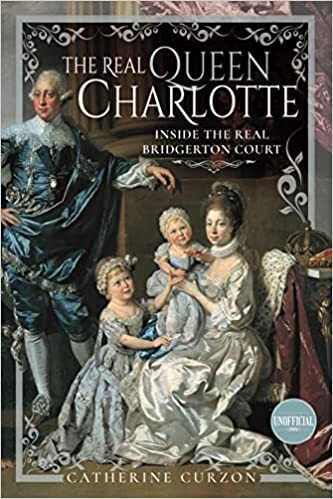
The Real Queen Charlotte: Inside the Real Bridgerton Court
Hardcover – 31 August 2022 (UK) & 30 October 2022 (US)
Known to millions as the imperious matriarch of Bridgerton’s court, Charlotte of Mecklenburg-Strelitz was still a teenager when she was chosen to be the bride of King George III. Shy, innocent, and sheltered, the orphaned princess and her youthful groom carried the hopes of a nation on their shoulders. The placid and unassuming young couple symbolised a new beginning, but soon those hopes began to sour. Charlotte and George’s marriage lasted for nearly 60 years and produced more than a dozen children, but it was beset by unrest at home, war in the colonies, and the king’s encroaching madness. As the royal couple battled against their critics, their political opponents, and sometimes even their own family, Charlotte learned what it really meant to be queen. Locked in a bitter struggle with her eldest son for the king’s future and with her daughters for their freedom, the timid young girl grew into an insular and domineering woman that few dared to cross. Shouldering the burden of family disputes, ambitious courtiers, and the care of the man she adored, Charlotte of Mecklenburg-Strelitz presided over one of the most tumultuous eras that the monarchy has ever seen. As tragic as it was glittering, this is the story of her extraordinary life.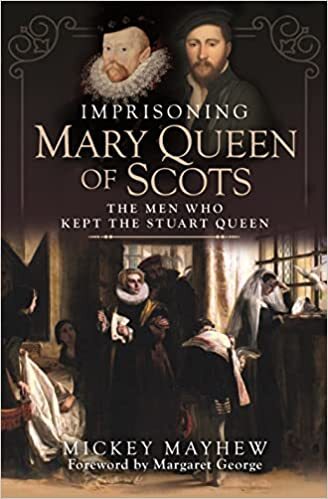
Imprisoning Mary Queen of Scots: The Men Who Kept the Stuart Queen
Hardcover – 30 August 2022 (UK) & 30 October 2022 (US)
Imprisoning Mary Queen of Scots covers the lives and careers of the men and women who ‘kept’ Mary Queen of Scots when she was a political prisoner in England, circa 1568/9-1587. Mary’s troubled claim to the English throne – much to the consternation of her ‘dear cousin’ Elizabeth I – made her a mortal enemy of the aforementioned Virgin Queen and set them on a collision course from which only one would walk away. Mary’s calamitous personal life, encompassing assassinations, kidnaps and abdications, sent her careering into England and right into the lap of Henry VIII’s shrewd but insecure daughter. Having no choice but keep Mary under lock and key, Elizabeth trusted this onerous task to some of the most capable – not to mention the richest – men and women in England; Sir Francis Knollys, Rafe Sadler (of Wolf Hall fame), the Earl of Shrewsbury and his wife, Bess of Hardwick, and finally, the puritanical nit-picker Sir Amyas Paulet. Until now, these nobles have been mere bit-players in Mary’s story; now, their own lives, loves and fortunes are laid bare for all to see.
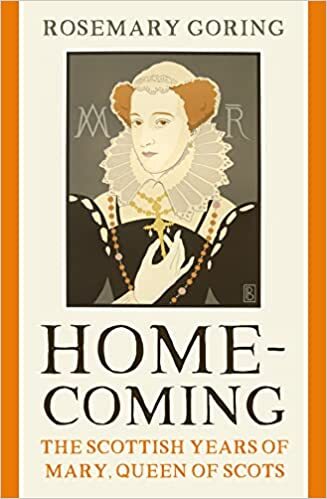
Homecoming: The Scottish Years of Mary, Queen of Scots
Hardcover – 4 August 2022 (UK) & 11 October 2022 (US)
One of the most famous queens in history, Mary Stuart lived in her homeland for just twelve years: as a dauntless child who laughed at her friendsʼ seasickness as they sailed to safety in France and later, on her return as a 18-year-old widow to take control of a nation riven with factions, dissent and religious strife. Brief though her time in Scotland was, her experience profoundly influenced who she was and what happened to her.
The post Book News August 2022 appeared first on History of Royal Women.
July 21, 2022
Book Review: Berenguela the Great and Her Times (1180-1246) by H. Salvador Martínez
*review copy*
Berenguela of Castile was born in 1180 as the eldest daughter of King Alfonso VIII of Castile and Eleanor of England. She was the heir presumptive to the Castilian throne for several years but was subsequently pushed down the line of succession by the births of her brothers Ferdinand (1189-1211) and Henry (1204-1217). The latter succeeded their father in 1214, but he would die young after being hit by a falling tile. Berenguela then became Queen of Castile in her own right, and by then, she had already lived through quite a few bumps in the road.
As a child, she was betrothed to Conrad II, Duke of Swabia, but this ended with his death in 1196. The following year, she married King Alfonso IX of León, and they had five children together before the marriage was annulled on the grounds of consanguinity. Luckily, they were able to establish the legitimacy of their children. Berenguela acted as regent for his minor brother and, upon his death, kept the crown for herself only long enough for her son to travel to her, and she was then able to abdicate in his favour. However, she continued to be her son’s closest adviser and was a very influential woman.
Berenguela the Great and Her Times (1180-1246) by H. Salvador Martínez examines the life of this extraordinary woman in detail, leaving no stone unturned. The attention to detail is quite something else. The academic nature of this book can sometimes make it feel like it’s dragging on a bit, and it was a little difficult to pick up again after a pause. Overall, I enjoyed this look at one of the greatest Queens in history, and I can only hope that the paperback version of this book, if it ever comes, does not carry the atrocious price tag of the hardcover version.
Berenguela the Great and Her Times (1180-1246) by H. Salvador Martínez is available now in the US and the UK.
The post Book Review: Berenguela the Great and Her Times (1180-1246) by H. Salvador Martínez appeared first on History of Royal Women.
July 20, 2022
A first look at STARZ’s The Serpent Queen
Samantha Morton, also known for her role as Mary, Queen of Scots in Elizabeth: The Golden Age, will portray Catherine de’ Medici, Queen of France, in the upcoming series The Serpent Queen.
— The Serpent Queen (@serpentqueen) July 14, 2022
Samantha Morton will star alongside Charles Dance as Pope Clement, Liv Hill as the younger version of Catherine, Antonia Clarke as Mary, Queen of Scots, and Ludivine Sagnier as Diane de Poitiers. An exact release date is not yet known, but the series will be released in the autumn.
The post A first look at STARZ’s The Serpent Queen appeared first on History of Royal Women.
July 19, 2022
Maria of Castile – A failed marriage but a successful political partnership
Maria of Castile governed Aragon from 1420-1423 and 1432-1458. She was Queen of Aragon and Naples. She was once the Princess of Asturias in Castile. She married King Alfonso V of Aragon. While their marriage was unhappy, they managed to form a political partnership. While her husband ruled in Naples, Queen Maria was the unofficial ruler of Aragon. She had her own court and council that was separate from her husband. During her years as the unofficial ruler of Aragon, Queen Maria was an advocate of peace.[1]
Maria of Castile was born on 14 November 1401. She was the oldest child of King Henry III of Castile and Queen Catherine of Lancaster.[2] Until her father had a son, Maria was made the Princess of Asturias (a title for the heir presumptive) on 6 January 1402.[3] When her brother, Prince John, was born on 6 March 1405, Maria was no longer the Princess of Asturias.[4] On 25 December 1406, King Henry III of Castile died, and her infant brother, John became King of Castile. Maria was four years old and became again heiress apparent of Castile until her brother produced an heir.[5] Her mother, Queen Catherine, became regent. Queen Catherine and Princess Maria developed a close mother-daughter relationship. Later, Princess Maria would learn from her mother how to rule.[6] They often corresponded with each other after Princess Maria married Prince Alfonso of Aragon.[7]
When Maria was seven years old, she became betrothed to Prince Alfonso of Aragon (the future Alfonso V). It was agreed that Princess Maria’s brother, Prince John, would marry Prince Alfonso’s sister, Princess Maria of Aragon.[8] In return, Princess Maria had to marry Alfonso of Aragon.[9] On 12 June 1415, Princess Maria married Prince Alfonso of Aragon, and she was given a large dowry. In fact, she is known in Spanish history for being the Castilian princess with the largest dowry.[10] Prince Alfonso was also rewarded by becoming a prince of Castile.[11]
On 1 April 1416, King Ferdinand I of Aragon died and Alfonso became King Alfonso V of Aragon. He did not have a coronation because he believed it was not necessary to prove his legitimacy as King since his father was King.[12] Thus, Queen Maria and King Alfonso V of Aragon were never crowned.[13] During Alfonso’s early years as King, Queen Maria was often overshadowed by her mother-in-law, Eleanor of Albuquerque.[14] Queen Eleanor was King Alfonso V of Aragon’s most trusted advisor and always assisted him in politics. Only when it was necessary did Queen Maria make public appearances.[15] Thus, Queen Maria had no political influence.
Queen Maria’s marriage to King Alfonso V of Aragon was initially happy. However, Queen Maria began to have health problems and was frequently ill.[16] She had smallpox which scarred her and made her look unattractive to her husband.[17] She also had epilepsy which she would suffer from for the rest of her life.[18] Because of her bad health, the couple could not consummate their marriage until Queen Maria finally began to menstruate at the age of sixteen.[19] Still, she could not produce a child with King Alfonso V of Aragon.[20] Queen Maria’s childlessness began to deteriorate their marital happiness.[21] King Alfonso V of Aragon began to have extramarital affairs.[22]
In 1421, Queen Joanna II of Naples named King Alfonso V of Aragon as her heir. King Alfonso V left to secure his claim to the throne of Naples. Before he left, he needed someone to rule the kingdom in his stead.[23] His mother’s health was in a poor state.[24] He did not trust his brothers because they often warred with Castile.[25] He needed someone who was faithful to him and could be a peacemaker between Aragon and Castile. He found that no one was more suitable than his wife.[26] King Alfonso V of Aragon made Queen Maria lieutenant-general. This meant that she was the unofficial ruler of Aragon. Queen Maria could make many decisions.[27] She answered to no one except her husband.[28] By becoming lieutenant-general, Queen Maria had her own court and council.[29] She often appointed Aragonese noblemen to positions within her court, which increased her popularity.[30] Queen Maria would serve as lieutenant-governor from 1420-1423.
In 1423, King Alfonso V of Aragon returned from Naples. When Queen Maria learned that her husband had an illegitimate son named Ferdinand with his lover named Giraldona Carolino, she was furious.[31] In order to get revenge on her husband for his betrayal, Queen Maria told her husband that his precious mother was dead.[32] However, Queen Eleanor was still alive.[33] When King Alfonso V of Aragon found out about his wife’s lie, he was so angry that he never forgave her.[34] Their marriage was irreconcilable.[35] King Alfonso V of Aragon stayed with her for nine years merely for appearance’s sake.[36]
In 1432, King Alfonso V of Aragon left to conquer Naples again. This time he would never return to Aragon.[37] King Alfonso V wanted to make his brother, John of Navarre, his lieutenant-governor general.[38] However, his court wanted his wife to be lieutenant-governor.[39] King Alfonso V of Aragon listened to his court and made Queen Maria the lieutenant-governor of Aragon.[40] She would be lieutenant-governor from 1432-1454.
As lieutenant-governor for the second time, Queen Maria proved to be a strong ruler and was an advocate for peace.[41] In 1435, King Alfonso V of Aragon was captured in the battle of Ponza, and Queen Maria raised funds to secure his release. Her most significant contribution was securing peace with Castile between her sister-in-law, Queen Maria of Aragon.[42] The two Queens met at Valladolid to sign a peace treaty between their two countries.[43] However, Queen Maria often struggled between handling the conflicts between the nobles and the peasants.[44] She also often disagreed with her husband’s policies on how to handle the conflicts between the two classes.[45]
On 2 June 1442, Maria became Queen of Naples when Alfonso V of Aragon became King of Naples. However, she never visited Naples. Because Queen Maria often disagreed with her husband’s policies, she resigned from lieutenant-general in August of 1453.[46] Her resignation was unprecedented.[47] Never before had a queen who was lieutenant-general resigned from power.[48] This resignation showed her frustration with her husband because she no longer wanted to work with him on a political level.[49] Even though she resigned, she still kept the title of lieutenant-general.[50] On 20 July 1454, her brother, King John II of Castile, died. Queen Maria moved back to Castile to negotiate peace between Aragon and her nephew, King Henry IV of Castile.[51] She stayed in the royal court of Valencia for the rest of her life.[52]
On 27 June 1458, King Alfonso V of Aragon died in Naples. He made no mention of Queen Maria in his will.[53] Queen Maria greatly mourned his death.[54] King Alfonso V of Aragon’s brother, John of Navarre, succeeded him as the next King. On 4 September 1458, Queen Maria died in Valencia.[55] In her will, she left a collection of over seventy books to her closest attendant, Yolanda de Monplau.[56] On 7 September 1458, Queen Maria was buried in the Monastery of Saint Trinity in Valencia.[57] Thus, Maria of Castile was one of the most powerful women in medieval Spain. While her marriage with King Alfonso V of Aragon was unhappy at a personal level, they managed to form a successful political partnership.
Sources:
Earenfight, T. (2010). The King’s other Body: María of Castile and the Crown of Aragon. Philadelphia: University of Pennsylvania Press.
Jansen, S. (2002). The Monstrous Regiment of Women: Female Rulers in Early Modern Europe. NY: Palgrave Macmillan US.
[1] Jansen, 2002
[2] Jansen, 2002
[3] Earenfight, 2010
[4] Earenfight, 2010
[5] Earenfight, 2010
[6] Earenfight, 2010
[7] Earenfight, 2010
[8] Jansen, 2002
[9] Jansen, 2002
[10] Earenfight, 2010
[11] Earenfight, 2010
[12] Earenfight, 2010
[13] Earenfight, 2010
[14] Earenfight, 2010
[15] Earenfight, 2010
[16] Earenfight, 2010
[17] Earenfight, 2010
[18] Earenfight, 2010
[19] Earenfight, 2010
[20] Earenfight, 2010
[21] Earenfight, 2010
[22] Earenfight, 2010
[23] Earenfight, 2010
[24] Earenfight, 2010
[25] Earenfight, 2010
[26] Earenfight, 2010
[27] Earenfight, 2010
[28] Earenfight, 2010
[29] Earenfight, 2010
[30] Earenfight, 2010
[31] Earenfight, 2010
[32] Earenfight, 2010
[33] Earenfight, 2010
[34] Earenfight, 2010
[35] Earenfight, 2010
[36] Earenfight, 2010
[37] Jansen, 2002
[38] Earenfight, 2010
[39] Earenfight, 2010
[40] Earenfight, 2010
[41] Jansen, 2002
[42] Jansen, 2002
[43] Jansen, 2002
[44] Earenfight, 2010
[45] Earenfight, 2010
[46] Earenfight, 2010
[47] Earenfight, 2010
[48] Earenfight, 2010
[49] Earenfight, 2010
[50] Earenfight, 2010
[51] Earenfight, 2010
[52] Earenfight, 2010
[53] Earenfight, 2010
[54] Earenfight, 2010
[55] Earenfight, 2010
[56] Earenfight, 2010
[57] Earenfight, 2010
The post Maria of Castile – A failed marriage but a successful political partnership appeared first on History of Royal Women.
July 17, 2022
The Year of Empress Elisabeth – A slave to her hair
Empress Elisabeth of Austria’s hair became an obsession of hers over time, and it eventually grew down to her heels. She once stated, “I am a slave to my hair.”1 To manage it, Elisabeth hired a woman named Fanny Angerer. She found Fanny at the Burgtheater after she noticed the wonderful hairstyle of the leading actress Helene Gabillon. Fanny was hired for 2,000 fl a year to “devote herself to the most exalted service as imperial hairdresser.”2
Fanny not only knew how to do hair, but she also learned to deal with the eccentric Elisabeth. For example, she often hid combed-out hair on a piece of tape and soon earned the Empress’s complete trust. If Fanny was ill or unavailable, Elisabeth would refuse to appear in public. She took a personal interest in Fanny and helped Fanny to get married, even though this usually would have meant leaving court. Fanny was allowed to remain at court, and her husband was given a position as well. Fanny was also used as Elisabeth’s double from time to time as a result of her “faultless bearing.”3 Fanny eventually became arrogant and rude, and one lady-in-waiting complained of her “shamelessly playing the grand lady.”4 Fanny left court two years before the Empress’s death.5
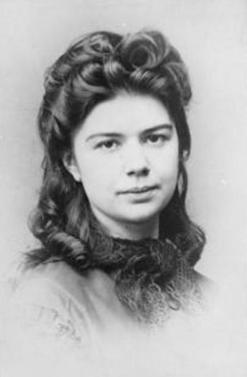 Fanny (public domain)
Fanny (public domain)Elisabeth’s hair was washed every three weeks – at first with precious essences until the preferred concoction became cognac and egg. Afterwards, it was rinsed with a “disinfectant.” Elisabeth then put on a long waterproof silk wrapper and walked until her hair was dry.6 In later life, she probably also dyed her hair with indigo and an extract made from walnut shells.7 The actual hairdressing could take up to three hours every day.
Archduchess Louise described the scene of hairdressing in her memoirs. “The Empress was really a lovely woman, and her hair was exquisite. When it was unbound, it simply enveloped her, and one maid was specially selected to dress it. The coiffure was carried out in rather a strange way. The carpet in the dressing-room was covered with white linen sheeting, and the Empress sat on a low chair in the middle of the room. The maid was dressed in white, and a most curious proceeding took place when the process was over of brushing and combing the luxuriant tresses and braiding them into the elaborate plaits affected by the Empress. The maid collected and counted every hair that remained in the brush and comb, and active search was also made on her dress and on the carpet for any hairs which had fallen out. The numbed was then told the Empress, who was exceedingly displeased if she thought too many hairs had come out during the “dressing”, and the maid had a mauvais quart d’heure in consequence.”8
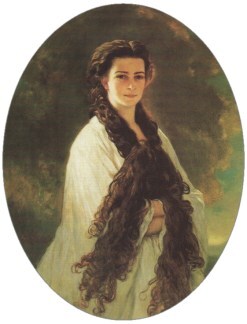 (public domain)
(public domain)Elisabeth’s Greek reader also described the scene. “Behind the Empress’s armchair stood the hairdresser (Fanny) in a black dress with a long train, a white apron of spider webs tied in front; though a servant herself, of an imposing appearance, with traces of faded beauty on her face, and eye filled with sinister intrigues… With her white hands she burrowed in the waves of hair, raised them and ran her fingertips over them as she might over velvet and silk, twisted them around her arms like rivers she wanted to capture because they did not want to run but to fly. Then in a silver bowl she brought her mistress’s dead hair for inspection, and the looks of the mistress and her servant crossed for a second – containing a slight reproach in that of the mistress, guilt and remorse speaking in that of the servant. Then the white lace robe was lifted from the falling shoulders, and the black Empress, like the statue of a goddess, rose from the sheltering garment. Then the mistress lowered her head – the servant sank into the ground, softly whispering, ‘I lay myself at Your Majesty’s feet,’ and so the sacred ritual was completed.”9
Elisabeth told her reader, “I am aware of my hair. It is like a foreign body on my head.” He responded, “Your Majesty wears her hair like a crown instead of the crown.” To which she replied, “Except that any other crown is more easily laid aside.”10 The weight of her hair often caused headaches, and if she had headaches, her hair would be lifted up high with ribbons to decrease the weight on her head. Nevertheless, for Elisabeth, her hair was part of her allure, and she used the time the hairdressing took to learn languages.
The post The Year of Empress Elisabeth – A slave to her hair appeared first on History of Royal Women.



